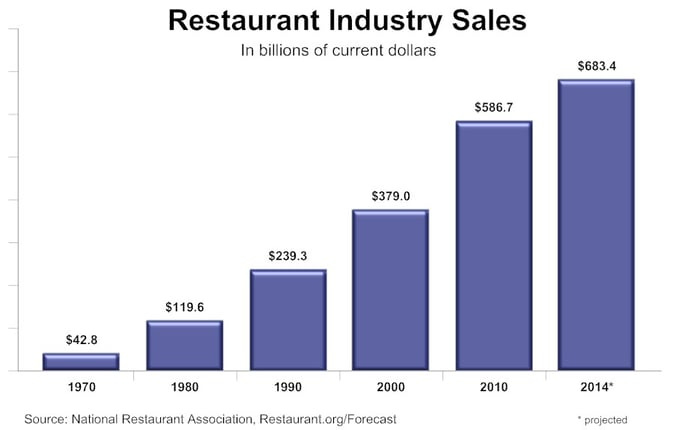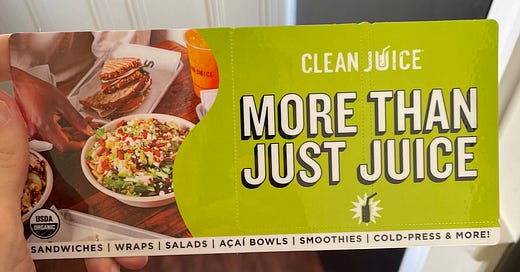Purpose Champions,
Your company name serves as a first impression.
I received this mailer the other day (see below). I assume Clean Juice needs help getting people in the door.
The restaurant is close to my house. I’ve walked in before, only to walk out without a purchase as I couldn’t justify spending $8 bucks for juice.
Here’s what I’m picturing from the head juice people:
“Our juice is so good; why aren’t people coming in? We also have all these other healthy menu items. WAIT A MINUTE, do people know we are more than just juice?”
Ergo 👇
It’s dangerous to name your business by just one product (unless you’re Panera Bread, but I’ll get to that).
Quick side note before we go on - for Clean Juice’s sake, I hope I’m wrong. I don’t know the numbers of their business, but writing this based on fundamentals and my gut reaction as an experienced marketer. They have 129 franchises across the US, so they are doing many things right! And their website is beautiful. This is one siloed marketing experience.
According to Franchise Chatter, these are the top 10 juice and smoothie bars.
Orange Julius
Smoothie King
Tropical Smoothie Cafe
Jamba (look who dropped the juice)
Booster Juice
Freshii
Nekter Juice Bar
Planet Smoothie
Clean Juice
Maui Wowi
If you read the site further, you’ll see the common theme of SMOOTHIE. All are trying to race to the top with better ingredients and removing all the bad stuff.
Clean Juice is competing in the same category as everyone else, including smoothies and adding menu items, trying to overcome objections like, “It’s just expensive juice.”
Clean Juice Doesn’t Own the Juice Category
Clean Juice should have taken Christoper Lochhead’s advice, “Follow your Different™.”
If Clean Juice wants to differentiate itself from the rest of the pack, they must own the juice. Instead of saying, “more than just juice,” I would have liked to see something like:
Why juice is healthier than smoothies.
(To use another Lochheadian term, “Dam the Demand” for smoothies)
They could be so bold to say, “Meet the King,” so next time Smoothie King (a category leader) pops into the mind, one thinks, “Maybe I should try that juice king place.”
I want to see Clean Juice dominate the juice niche. Separate themselves from all those others trying to squeeze the juice out of the juice and smoothie bar category. Stop worrying about the perceptions of only being juice and convince the world why juice is the future of healthy living.
Don’t wheeze the juice. 👇
Are You Wheezing the Juice?
Let’s look at this from a strategic marketing perspective. If you’re looking to grow your business, there are four quadrants to consider.
The 4 Quadrants
Promote the category: For the category leaders, the Orange Julius of the world telling people to “Drink More Smoothies.” Or maybe Ovaltine.
Increase $ the value of loyal customers: Focusing on your best customers who always choose you. Apple fits this quadrant best as they continue innovating on the same devices and creating new products for their loyalists (superconsumers).
Increase the value of brand flippers: This is wheezing the juice, a tug of war, and, unfortunately, where many brands play. It’s a me-too strategy, like adding menu items, “Hey, we got this too.”
Target Competitive Users: This is taking (earning) the juice. A dam the demand strategy. You don’t want that; you want this. It’s focusing on your dynamic variable that sets you apart.
For startups, you want to be in quadrant 1 or 4 (depending on how similar/different you are from existing categories). Your quadrant is the beginning - the rest of your decisions flow from it, and Pitch Purpose Marketing can help.
So for Clean Juice, you have two options:
Backpedal and try to convince your target market you’re “more than just juice” (therefore wheezing the juice).
Dominate your juice niche.
Which will you choose?
The Success of Panera Bread
According to Startup Sapien, the St. Louis Bread Company became known as Panera Bread in 1997.
Chipotle Mexican Grill opened its doors in 1993.
The 90s saw the fast-casual restaurant category emerge, and Panera Bread became a category king.
See the chart below for the growth of fast-casual restaurants from 1970-2014.

The St. Louis Bread Company was famous for, you guessed it, bread. But, it wasn’t bread that excited the owner, Ron Shaich. He saw the emergence of the fast-casual restaurant segment, and he wanted to be a leader with Panera.
Panera was differentiating itself by focusing on the customer experience of the new fast-casual category that they were defining, becoming “the largest free WiFi provider in the U.S. in 2004”, introducing healthy options before it was cool, being a comfortable “gathering place,” convenience of fast food without feeling like fast food, etc.
According to ChatGPT, through its fancy website scrubbing, “St. Louis Bread Company was founded in 1987 by Ken Rosenthal, who opened the first location in Kirkwood, Missouri. At the time, the company primarily sold freshly baked bread and other baked goods, such as bagels, muffins, and pastries, to local customers.”
In other words, they were initially focused on just the bread. Sure, they had other menu items, but they dominated artisan bread.
Their evolving expansion into who they are in 2023 flowed naturally, so they became more than just bread. Ironically, they released this commercial several years ago. 🤦 Good thing they weren’t in a spot they had to convince us, just remind us.
I’ll close with a fun fact from Panera Bread’s Twitter, or should I say Bread Basket Bread’s Twitter.
Au Revoir,
Tony






